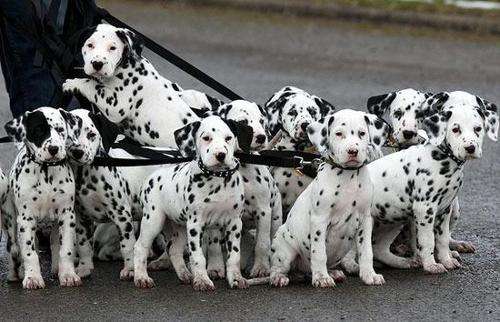Dalmatian
IUCN
LCBasic Information
Feature
Disneyland's most popular dog
Distribution and Habitat
Originally from Yugoslavia
Appearance
The ears are medium in size, slightly broad at the base (in proportion), tapering to a slightly rounded tip. They are set high and close to the head, with the earlobe being thin and fine in texture. When the Dalmatian is alert, the tops of the ears are level with the top of the head, and the tips of the ears extend to the bottom line of the cheeks. The top of the head is flat, with a slight longitudinal indentation in the middle, and the width of the skull is equal to its length. The nose is well pigmented, black in black spotted dogs and brown in liver spotted dogs. A lack of pigment (partially or completely flesh-colored nose) is a serious fault. The chest is large and moderately wide, with well-sprung ribs but not barrel-chested. The chest extends to the elbows. The chest is a graceful curve with a moderate lift to the rear of the body. The back is level and strong. The flank is fairly narrow throughout the loin. The forelegs are straight, strong, and well-boned. The hindquarters ar
Details
The Dalmatian is an animal with a long history, and its unique spots are undoubtedly one of the most conspicuous symbols of dogs.

Dalmatian is recognized as one of the most elegant breeds, with white and clear black spots, and can call people. According to ancient Greek sculptures and ancient Egyptian murals, this dog has a history of thousands of years. Some people believe that it originated in Egypt and India. Because it is loved by gypsies, it has spread throughout Europe. In the 19th century, British and French nobles used it as a guard dog for carriages, running behind and behind the carriages. Some people called it a carriage dog. The coat color and spots are one of the important criteria for judging Dalmatian dogs, and any coat with spots other than black spots and reddish-brown spots is inferior.
Dalmatian dogs are one of the few dog breeds that originated in Yugoslavia. Both the appearance and facial expressions are very similar to Bengal Pointer Hounds. It was once written into Dodie Smith's novel "100 and One Dalmatians" and later adapted into a cartoon by Disney, which became widely known. There are many fans in Europe, America, and Japan.
The traditional mission of Dalmatian dogs is to accompany their owners to escort horses and ox carts on long journeys without being attacked by bandits. Dalmatian is silent and sensitive. It is polite but reserved to strangers. It has highly developed guarding instincts and is a keen and reliable guard dog. Dalmatian has short and thick fur and does not need to be combed frequently. However, this dog is strong and energetic with excellent speed and endurance, so it needs to be given ample time to exercise. Dalmatian is best kept in a house with a courtyard where it can run freely. Dalmatian is an ideal companion dog. It is alert, likes to please people, has a kind and outgoing personality, and is a beautiful and loyal family pet. Dalmatian is a daredevil in the dog world. Its behavior is very funny, but parents with children at home should pay special attention. Dalmatian likes to jump on people and can easily knock children down accidentally. Another considerable feature of this dog is lust. It is worth noting that Dalmatian and English Pointer are very similar in appearance and should be distinguished.
Protect wild animals and stop eating game.
Maintaining ecological balance is everyone's responsibility!








